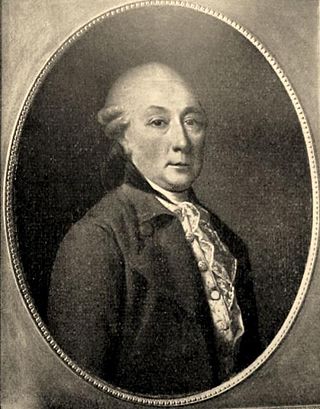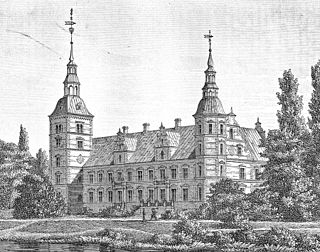
The Berritzgaard estate and manor house is one of the largest and best preserved manor houses on the island of Lolland in Denmark. The estate can be traced back to 1382, to its first owner, Markvard Pøiske. The estate developed from a village called "Berith", situated where the Berritzgaard manor house now stands. Later, the Huitfeldt family purchased the estate. Jacob Huitfeldt and his wife Lisebeth Friis built the present manor house that was constructed by Hans van Steenwinckel the Elder. Lisebeth Friis was widowed before the house was finished in 1586.

Bregentved is a manor house located 3 km east of Haslev on the Danish island of Zealand. It has been owned by the Moltke family since the middle of the 18th century.

Rudbjerggaard, situated 7 km south of Nakskov, is the only half-timbered manor house on the island of Lolland in south-eastern Denmark.

Torbenfeldt Castle is a manor house located 15 km south-west of Holbæk on the island of Zealand in eastern Denmark. The estate covers 1,711 hectares of land (2000).

Poul Abraham Lehn, Baron of Lehn and Baron of Guldborgland, was a feudal baron of the Danish and Norwegian nobility and one of the greatest landowners of his time in Denmark.

Pederstrup is a historic manor house located 12 km (7.5 mi) north of Nakskov on the Danish island of Lolland. The half-timbered building from 1686 was rebuilt from 1813 to 1822 in the Neoclassical style by the statesman Christian Ditlev Frederik Reventlow. Since 1940, it has housed the Reventlow Museum.

Krenkerup is an old manor house located 3 km (2 mi) southwest of Sakskøbing on the Danish island of Lolland. It is one of Denmark's oldest estates and manors, documented as early as the 1330s. Between 1815 and 1938, it was known as Hardenberg.

Skaføgård is a manor house in the parish of Hvilsager in Syddjurs Municipality in the eastern Jutland peninsula of Djursland, Denmark. It is not one of Denmark's largest manor-houses, but one of the best preserved. Inside there is an enormous oak closet carved by the Dutch carpenter Mikkel van Gronningen whose most famous work is the pulpit in Århus Cathedral. The closet covers 13 m2 (140 sq ft) of wall space and, in view of its rich detail, is considered to be one of the most outstanding examples of carved wooden Renaissance furniture in Northern Europe.

Sæbyholm was a manor house located close to Maribo on the island of Lolland in southeastern Denmark. The estate was acquired byChristian Heinrich August Hardenberg-Reventlow of Krenkerup in 1801 and has been owned by his descendants since then. The three-winged main building and the home farm were listed on the Danish registry of protected buildings and places in 1960. The buildings were delisted in 2012 and demolished in 2013.

Christianssæde is a manor house and estate located close to Maribo on the island of Lolland in southeastern Denmark.
Højbygård is a manor house and estate located on the island of Lolland in southeastern Denmark. It has since 1825 belonged to members of the Lehn family. The current main building is from the 18th century but has been altered several times.

Orebygaard is a manor house and estate located on Lolland in southeastern Denmark. The current main building, a Neo-Renaissance style building with two towers, is from 1872–1874. It was listed on the Danish registry of protected buildings and places in 1985.

Turebyholm is a manor house in Faxe Municipality, some fifty kilometres southwest of Copenhagen, Denmark. It was acquired by Adam Gottlob Moltke in 1746 and has remained in the hands of the Moltke family to the present day. It was part of the Countship of Bregentved from 1756 to 1920 and still shares its ownership with the Bregentved estate. The current Rococo-style main building was constructed by royal architect Niels Eigtved in 1750. It was listed on the Danish registry of protected buildings and places in 1918.

Søholt is a manor house located on the southern shore of the Maribo Lakes on Lolland in southeastern Denmark. The main building is from 1804 but was adapted to the Renaissance Revival style in the second half of the 19th century. The Baroque-style garden is open to the public.

Næsbyholm is a manor house and estate located east of Tybjerg Lake, between Sorø and Glumsø, in Næstved Municipality, some 70 km (43 mi) southwest of Copenhagen, Denmark. Since 1610, Næsbyholm and Bavelse have had the same owners. The three-winged Dutch Renaissance-style main building was reconstructed after fires in 1932 and 1947, incorporating elements from 1585. It is now used as a venue for weddings, conferences and other events. The scenic park was laid out in the 18th century. The Næsbyholm-Bavelse estate covers 1,424 hectares of land (2012), of which approximately half is forest.
Ryegaard is a manor house and estate in Lejre Municipality, Denmark. Ryegaard and neighbouring Trudsholm is owned by the Rosenkrantz/Skeel families since the year 1735. The two estates add up to a combined area of 1,228 hectares.

Fredsholm is a manor house and estate located close to Nakskov on the island of Lolland in southeastern Denmark. Fredsholm and Rudbjerggaard had the same owners in the period 1674–1819.

Frederiksdal is a manor house and estate located 10 km northwest of Nakskov on Lolland, in southeastern Denmark. The estate covers 538 hectares of land. It is known for its fortified cherry wine.

Kjærstrup, or Kærstrup, is a manor house and estate located 9 kilometres East of Rødbyon Lolland, Lolland Municipality, in Southeastern Denmark. The two-storey, half-timbered main building was faced with brick in 1836 and a central tower in the front was added in 1868. The building was listed on the Danish registry of protected buildings and places in 1918. The adjacent farm buildings date from the early 1910s and are not part of the heritage listing. A Baroque style garden from around 1765 was restored in around 1900. The estate covers 487 hectares of land.

Tølløsegård, also known as Tølløse Castle, is a former manor house and estate located at Tølløse, Denmark. It has since 1997 been operated as a school under the name Tølløse Slots Efterskole. The current main building was built after a fire in 1944.





















